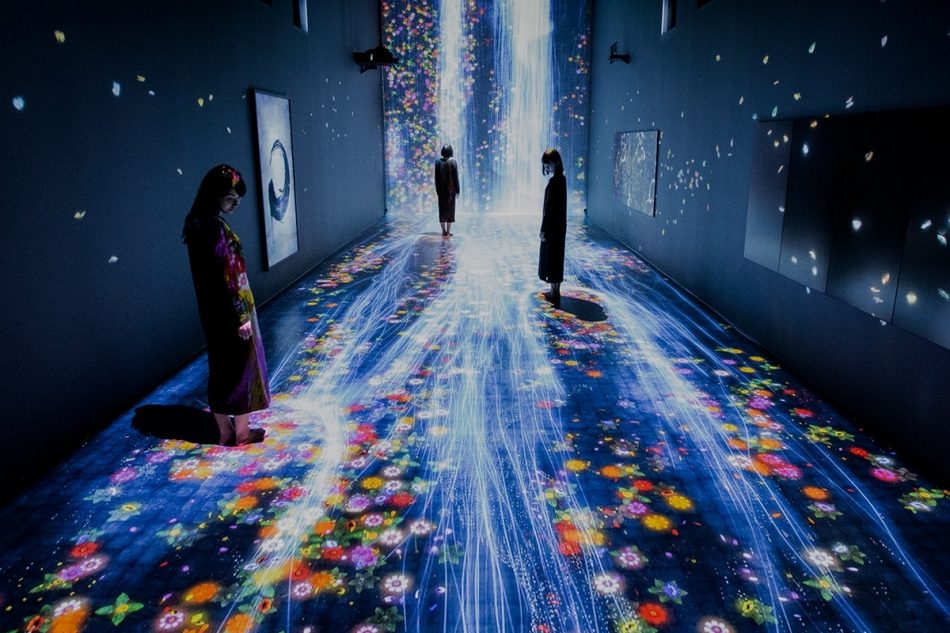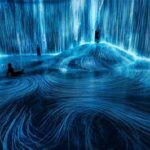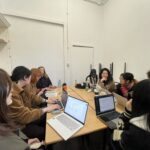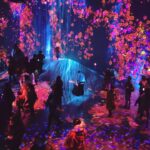This week, building on Adam Benmakhlouf’s lecture on Publishing as Curatorial Practice, I reconsidered my Expanded Cinema project’s conceptual foundation. Rather than treating my exhibition as a fixed presentation of cinematic content, I am increasingly approaching the space as a dynamic, participatory publication—a site where spectators continuously generate ephemeral narratives through embodied interaction.
Drawing from Benmakhlouf’s discussion, publishing extends curatorial influence beyond the immediate exhibition timeframe, creating a “new impression on the skin of the social” (Ahmed, 2006). Publications—whether material or digital—become curatorial acts that reshape relationships between works, audiences, and contexts. My project aims to activate similar mechanisms by designing a space where light, sound, and projected images form an unstable environment that evolves with each visitor’s movements.
Spatial Pre-setting: Building a Cinematic Atmosphere
In order to immerse visitors immediately into a “cinematic world”, I structured the exhibition space with several strategies:
-
Unified Visual Language: High-contrast lighting, narrow spotlights, and dark zones replicate a filmic atmosphere. Projections use actual cinematic footage rather than abstract animations to reinforce narrative realism.
-
Cold Start Fragment: Upon entry, spectators encounter a fragmented video sequence suggesting an unfinished narrative—broken shots of landscapes, distant figures, or drifting objects—prompting the sense of entering the middle of an ongoing story.
-
Cinematic Soundscape: Ambient sounds (distant traffic, whispers, gusts of wind) create an enveloping sound environment. Interactive video fragments are tightly synchronised with corresponding sound effects, reinforcing emotional immediacy.
Through this multisensory setup, the space itself communicates the curatorial premise without verbal explanation: You are now inside a film, but your role and story remain unknown.
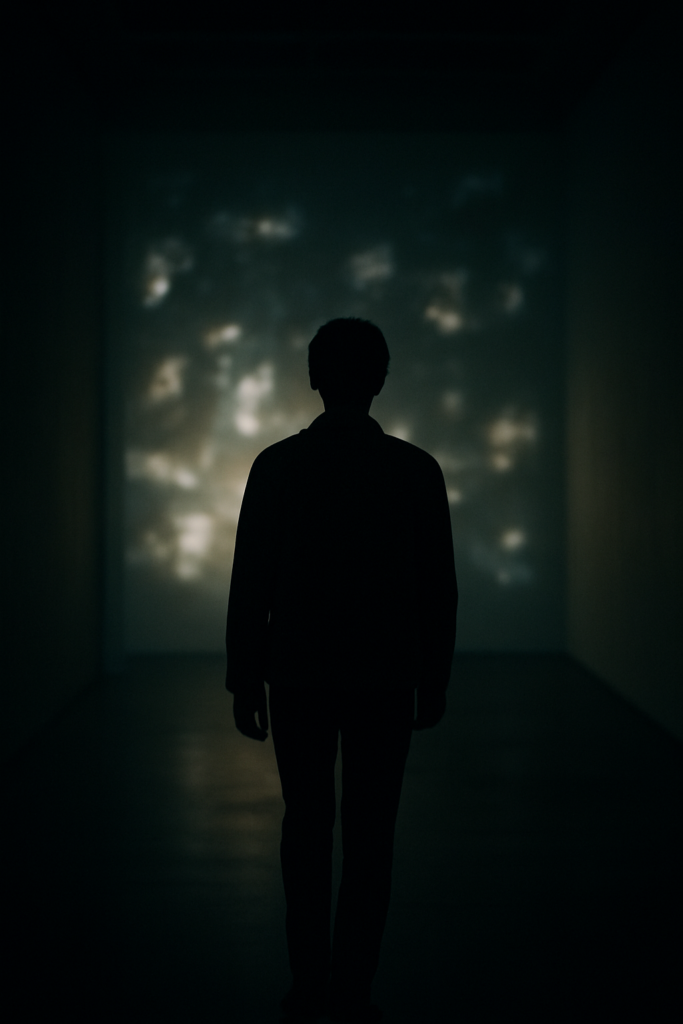
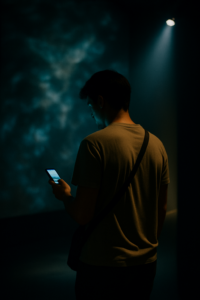
From Actions to Narrative: Avoiding Simple Action Mapping
To deepen the experience, I focused on designing action triggers that generate cinematic fragments, not mere animations:
-
Each interaction—gesture, movement, pause—activates a pre-recorded cinematic sequence following filmic grammar: zoom-in for close-up intimacy, pull-back for expansive distance, fast cuts for conflict, slow-motion for emotional resonance.
-
Triggers are organised into scene fragments rather than discrete effects. For example, waving might trigger the beginning of a chase scene; turning around might open a dream sequence.
This approach aligns with Gilbert’s argument that publishing today shifts from presenting artefacts to orchestrating processes and practices (Gilbert, 2016). Similarly, my project foregrounds spectators’ bodily processes as the medium through which narrative emerges.
| Audience Action | Triggered Camera Movement | Cinematic Effect | Narrative Intention |
|---|---|---|---|
| Step Forward | Push-in (camera moves closer) | Builds intimacy and focus | Introduces a crucial detail or emotional shift |
| Step Backward | Pull-out (camera moves away) | Expands space and context | Reveals broader environment, creates distance |
| Quick Turn / Spin | Rapid Cuts / Swish Pan | Generates tension and urgency | Simulates pursuit, chaos, or disorientation |
| Slow Arm Movement | Slow-motion tracking | Deepens emotional resonance | Highlights nostalgia, contemplation, or melancholy |
| Jump or Sudden Motion | Smash Cut or Jittered Frame | Disrupts rhythm sharply | Evokes shock, surprise, or escape reflex |
| Pause (No Movement) | Static Long Shot | Accumulates tension quietly | Suspends action, invites introspection |
Table 1. Mapping Audience Actions to Cinematic Techniques
The table summarises how specific audience actions are mapped to cinematic camera movements and editing techniques within the Expanded Cinema project, reinforcing narrative immersion through filmic language rather than game-based interaction.
Theorising the Space: Simulacra, Reality, and the Constructed Experience
In expanding the conceptual framework, I revisited Jean Baudrillard’s theory of simulacra (1981). Baudrillard argues that in contemporary media culture, images and representations no longer reference a stable reality; instead, they constitute a hyperreality, where the distinction between original and copy dissolves.
Applying this to my project, I recognise that:
-
The cinematic fragments triggered by audience actions do not refer to a fixed “real world”; they construct a new reality within the space.
-
Visitors are not decoding prewritten stories but co-producing layers of experience through their interactions.
-
The exhibition becomes a fourth-order simulacrum: a system of signs generating its own internal logic of meaning, independent of external referents.
Thus, the Expanded Cinema space operates as an ephemeral publication: an ever-changing script authored by the visitors’ gestures, within an environment where simulation replaces representation.
Reflecting on Tutor Feedback: Enhancing Feasibility, Research Breadth, and Thematic Coherence
This week’s developments are also shaped by my tutor’s feedback from earlier blog entries:
Feasibility and Budget: Recognising concerns about the project’s realism within a £10,000 budget, I have scaled the technical ambition. The system focuses on pre-edited video fragments with simple motion-sensor triggers, avoiding expensive live rendering or complex AI systems.
Expanding References: In response to advice to diversify my readings, I incorporated new sources beyond earlier references, including Publishing as Artistic Practice (Gilbert, 2016), Give Birth to Me Tomorrow (Benmakhlouf and Taal, 2021), How We Hold (Khalaf et al., 2022), and Baudrillard’s Simulacra and Simulation (1981).
Linking to Weekly Themes: I made conscious efforts to connect this week’s thinking not only to the Publishing lecture but also back to earlier themes around space, embodiment, and curatorial ethics, ensuring thematic continuity across blog posts.
This reflection process reinforces my commitment to developing an achievable, critically grounded, and theoretically informed final project.
Conclusion
Through integrating this week’s publishing frameworks and Baudrillard’s notions of simulation, I have refined my understanding of the Expanded Cinema project.
Rather than presenting a curated filmic experience, the exhibition operates as a live publication—a participatory, unstable, and ephemeral work authored collectively by audience bodies and movements.
In doing so, it aspires to transcend traditional spectatorship and invite visitors to inhabit, co-create, and momentarily rewrite a cinematic reality that exists only in their lived experience.
References
Ahmed, S. (2006) Queer Phenomenology: Orientations, Objects, Others. Durham: Duke University Press.
Baudrillard, J. (1981) Simulacra and Simulation. Paris: Éditions Galilée.
Benmakhlouf, A. and Taal, T. (2021) Give Birth to Me Tomorrow. Glasgow: LUX Scotland.
Gilbert, A. (ed.) (2016) Publishing as Artistic Practice. Berlin: Sternberg Press.
Khalaf, A., Thorp, A., Graham, E., Gatens, L. and Egan, J. (2022) How We Hold: Rehearsals for Art and Social Change. London: Serpentine Galleries.
